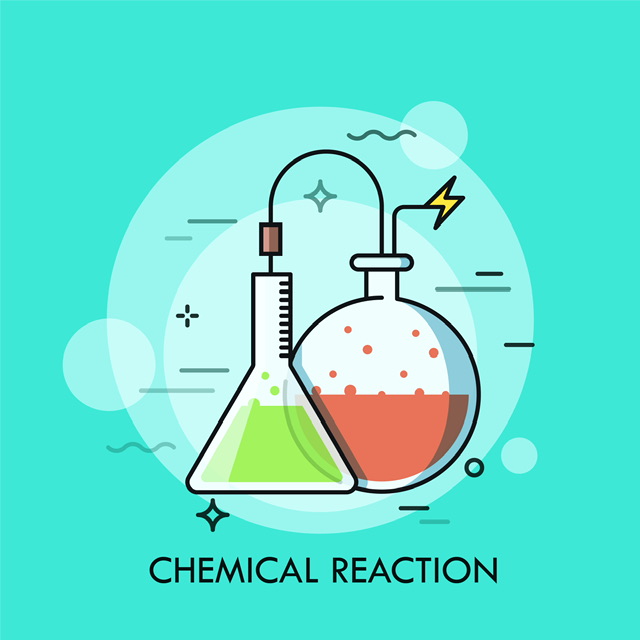We'll be back in a bit !
The system is currently undergoing a routine upgrade to ensure you get the best learning experience. The maintenance is expected to continue till 8:00 pm. Please check back later.
Thank you for your understanding!

Chemical reactions are processes in which atoms or molecules interact to form new substances with different properties than the original substances. Chemical reactions are essential for the production of many everyday items, from food and clothing to medicines and fuels. They can be used to create something new or to break down existing materials into simpler forms. Chemical reactions involve the transfer of energy, either from one molecule to another, or from the environment to the reacting molecules. This energy transfer causes the atoms or molecules to rearrange, forming new bonds and breaking existing ones. The result is a new substance with different properties than the original substances.
The various types of chemical reactions are-
Precipitation or double replacement reaction
Combination or synthesis type
Decomposition type
Displacement (single) type
Double displacement type
Neutralization type
Combustion type
Redox reaction (oxidation-reduction reaction)
An additional class of chemical reaction, precipitation reactions often include the combination of two bonds (typically ionic) to produce an insoluble salt or precipitate, and so take place in aqueous (water-containing) solutions. A solid residue known as precipitate is left behind after this reaction, making it an example of a twofold displacement reaction. The reaction is depicted below-
In this reaction, the acidic effect of acid is neutralized by the base and vice versa. During the formation of products, there is the generation of heat. In this (neutralization) reaction, the acidic proton from the acid reacts with the hydroxyl group of the base to give a water molecule. One example of such a reaction is depicted below-
A redox reaction is one in which oxidation and reduction take place simultaneously. The rusting of iron is a frequent and well-known example of a redox process.
A combustion reaction is an exothermic reaction that takes place in the presence of oxygen and a fuel such as hydrocarbons. One example of such a reaction is the burning of methane as shown below-
An example of a chemical reaction is the synthesis reaction, also known as the combination (addition) reaction, in which two or more reactants are combined to generate a new product. Magnesium oxide is created when magnesium ribbon is burned. This is a depiction of the response to the same.
When a complex or molecule is broken down into two or more simpler components, this is called a decomposition reaction. One such process is water electrolysis. Hydrogen and oxygen are produced when water is electrolyzed. The following is a response to the same-
Title: Decomposition of water
Broadly, decomposition reaction can be classified into three major types and those types of reactions are-
Thermal decomposition reaction- This is an endothermic reaction that requires thermal energy for initiating the reaction.
Electrolytic decomposition reaction- This is another type of decomposition reaction (opposite of combination reaction) where energy (chemical) in the form (way) of electricity is required to activate or initiate the reaction.
Photolytic or photodecomposition reaction- This is another type of decomposition reaction where energy in the form of light (photons) is required to activate or initiate the reaction.
Some examples of the decomposition (opposite of combination) reaction are as follows-
Decomposition of an acid called carbonic acid-
Decomposition of calcium carbonate-
Electrolysis of water-
Decomposition of ozone(O3)-
Some common uses of decomposition reaction are-
It makes cement and calcium oxide.
In antacids, it relieves dyspepsia.
It extracts metals from oxides, chlorides, etc.
For thermite welding.
A Decomposition reaction is very important for the digestion of food in the human body because it helps to decompose the carbohydrates and proteins consumed by us into simple sugars in the form of glucose and amino acids, which on further decomposition provides energy in our body.
Reactions include combination (addition), breakdown, precipitation, displacement, double displacement, combustion, and redox reactions. In an aqueous (water-containing) solution, two bonds (usually ionic) combine to form an insoluble salt or precipitate. An acid (H+) and a base (OH-) quantitatively react to produce salt and water in a neutralization reaction. Redox reactions combine oxidation and reduction. Most combustion reactions emit heat as energy. Synthesis reactions include two or more reactants forming a new product. Decomposition reactions (opposite combination reactions) break down molecules or compounds into simpler elements or chemically novel things.
The difference between a decomposition reaction and a synthesis reaction is that a decomposition reaction breaks down a compound into two or more simpler substances, while a synthesis reaction combines two or more simpler substances to form a more complex compound.
Catalysts are substances that speed up the rate of oxidation reactions by providing an alternative pathway for the reaction to take place.
A combustion reaction requires fuel, oxygen, and an ignition source like a spark or flame. Combustion reaction results in the release of energy thus, it is also necessary to keep safety wear while performing the reaction.
